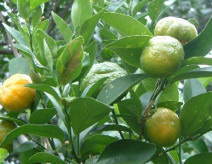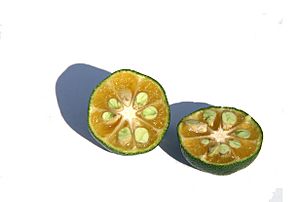Citrus depressa facts for kids
Quick facts for kids Citrus depressa |
|
|---|---|
 |
|
| Shiikwāsā on a tree | |
| Scientific classification | |
| Genus: |
Citrus
|
| Species: |
depressa
|
The Shiikwasha (also called Citrus depressa) is a small, green citrus fruit. It is very sour, like a lemon or lime. This fruit is originally from East Asia, especially Taiwan Island and the Okinawa Islands in Japan.
People often use Shiikwasha to add a sour taste to dishes, just like you would use a lemon or lime. It can also be made into jam or a yellow juice. This juice is usually mixed with water or sweetened because it's so sour! Sometimes, people mistakenly call it "calamansi," but it's actually a different fruit.
Shiikwasha grows mostly in southwest Japan, especially in the northern part of the main Okinawa island. It's one of two citrus fruits that are native to the Ryukyu Islands, the other being the Tachibana citrus.
What Does Shiikwasha Look Like?
The Shiikwasha tree usually grows to be about 3 to 5 meters (10 to 16 feet) tall. Its white flowers, which are about 3 centimeters (1.2 inches) wide, typically bloom in April.
The fruits start to appear around July. Each fruit weighs about 25 to 60 grams (0.9 to 2.1 ounces). When they are not ripe, their skin is a dark green. As they ripen, the skin turns yellow. Remember, even when yellow, these fruits are very sour and don't have much sugar!
How Did Shiikwasha Come to Be?
Scientists have studied the genes of Shiikwasha and other citrus fruits from Asian islands. They found that Shiikwasha is a natural mix of two different mandarin oranges.
One parent is a native mandarin from the Ryukyu Islands, called Citrus ryukyuensis. The other parent is a mandarin from mainland Asia, similar to the Chinese Sun Chu Sha mandarin. This means that Shiikwasha is a natural hybrid, created when these two different types of citrus plants crossed paths and shared their genes. This happened a long time ago, as Shiikwasha is even mentioned in old poems from the island kingdoms!
Images for kids
See also
 In Spanish: Shikwasa para niños
In Spanish: Shikwasa para niños




